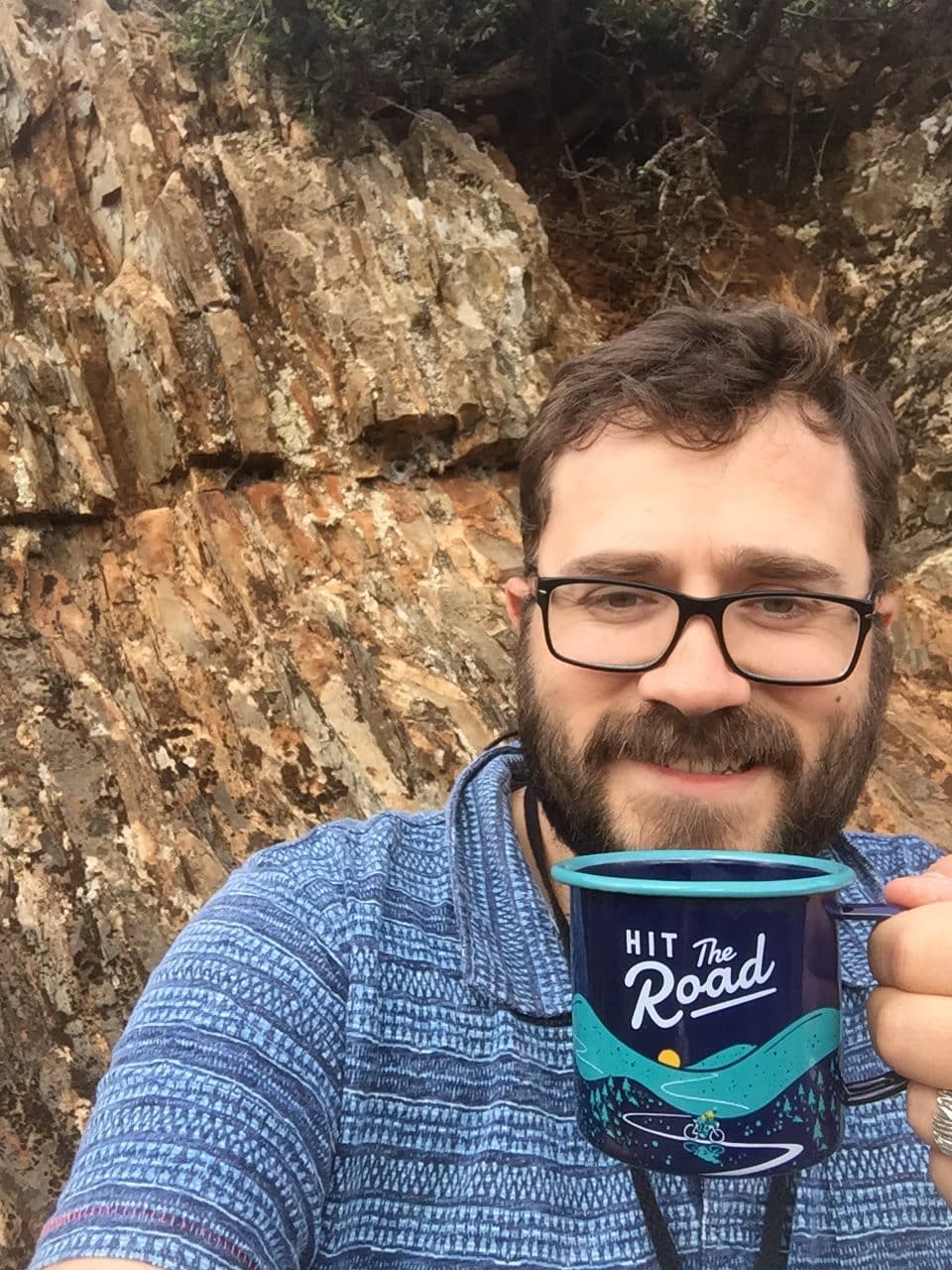What is a dinosaur highway?
Wednesday 5th Mar 2025, 12.30pm
If you were hunting for some fossilised dinosaur footprints, where would you go? To a remote part of North or South America, perhaps? A deserted wilderness for sure… But how about Oxfordshire? We chat to Dr Duncan Murdock from the Oxford University Museum of Natural History about an incredible discovery made right on our doorstep.
Photo © Dr Emma Nicholls / Oxford University Museum of Natural History
Emily Elias: For over 170 million years, dinosaurs roamed the planet. But we’re exactly where they roaming? Turns out a route they travelled near Oxford has been unearthed, and it’s revealed a prehistoric pathway. On this episode of the Oxford Sparks Big Questions podcast, we are asking ‘What is a dinosaur highway?’
Hello, I’m Emily Elias, and this is the show where we seek out the brightest minds at the University of Oxford, and we ask them the big questions. And for this one, we have found a researcher who’s on the case of the mysterious dinosaur footprints.
Duncan Murdock: Hi, I’m Dr Duncan Murdock. I’m a collections manager and earth scientist at the Oxford University Museum of Natural History.
Emily: Okay, Duncan, hold my hand, walk me through this. What the heck is a dinosaur highway?
Duncan: So when we say dinosaur highway, what we’re really talking about is a dinosaur trackway site. So this is an area of exposed rock where we have the footprints of dinosaurs preserved, and more importantly, a whole series of footprints from different individuals as they walked across this surface, leaving behind a track rate of footprints.
Emily: And this isn’t like a theoretical thing, right? Like this is an actual physical highway that you know about.
Duncan: Yeah, absolutely. Yeah, so this is the place where dinosaurs were walking across at a specific point in space and time.
Emily: Where is it?
Duncan: So the one that we’ve been working on is in a quarry in North Oxfordshire, called Dewars Farm Quarry, near Bicester, which is not too far from where I am in Oxford.
Emily: How did you find it? Is it just by chance?
Duncan: So dinosaur footprints and trackways have been known from this part of Oxfordshire since the late 1990s. The previous discoveries have been subsequently been buried below a waste disposal site. So there was quarrying activity that was continuing in the nearby area. And they were expecting that they might find further dinosaur footprints. But for several years, there’d been no discoveries. And then a couple of years ago, one of the quarry workers, Gary Johnson, who works for Smiths Bletchington, was scraping away some clay above the surface where they thought we could find dinosaur footprints and felt a series of unusual bumps. And thought, well, that’s a bit strange. So we got out, had a look, and thought maybe these are dinosaur footprints.
So that’s when we got involved. So he contacted us in Oxford, brought us down, and we were able to verify that he’d found, not only a few dinosaur footprints, but actually a huge trackway site.
Emily: Okay, so what do they look like? Is it like a very clear, like if I was a kid and I put my handprint in Play-Doh, and it really imprints, is it like that distinct with detail?
Duncan: So there’s two different kinds of footprints that we see at this site. There are these three-toed, tri-dactyl prints, and there you can see three distinct toes. So imagine it, you might have seen a bird walking across a beach sand, leaving behind little footprints, or on a snowy day, a robin that’s walked across a snowy field. And they look just like that, but you can clearly see these three toes. The other footprints we see are essentially big holes in the ground, with these sort of splodged-out, mounds of mud that we call displacement rims. And they come from much bigger dinosaurs. The only things that were alive that were big enough to make such huge prints, some of them are nearly a metre across are sauropod dinosaurs – these are four-legged, long-necked, long tails, herbivorous, plant-eating dinosaurs.
Emily: And how are you able to tell that it is actually like dinosaur tracks, and it isn’t just something random that’s left these like splodges in the ground?
Duncan: So we do this through two different kinds of lines of evidence. One is what we know about animals today, and what kinds of creatures leave behind trackways. And the other line of evidence is what fossils do we have from the time? So from this period, the middle Jurassic, so it’s around 166 million years ago, we have the bones of theropod dinosaurs and sauropod dinosaurs. So that’s these big carnivorous, three-toed animals, like Megalosaurus, and these large four-legged, long-necked, long-tailed things like Cetiosaurus. So we know that animals like this were alive at the time. Then we can compare it to footprints from things that they’re related to today. Things like birds, crocodiles, but also other large four-legged animals like elephants. And we can look at how they leave footprints behind and try and work out what kind of animals must these have been to have left behind the footprints that we see.
Emily: So what were they doing walking this pathway? Like were they heading to a very interesting postgraduate degree for dinosaurs in the area? Like what was going on in the terrain that we know that they could possibly be using this pathway for?
Duncan: So we can’t be entirely sure, but we know that at this time, this part of the country was these coastal lagoons. Think of bits like the Florida Keys today. So we have these patchy mud exposure and marine sea lagoons along a coastline. So these animals were walking along this coastline. The sauropod prints, these are those big prints. They have two different preferred orientations. They’re all going in one of two directions. Now one of which lines up really well with the coast that we believe was there. So these animals were walking along the coast. So whether they were moving between different sites where they could feed or whether they were moving because the climate was changing or they were moving to find mate. We can’t be sure, but we know they’re migrating along this coastline. Then there are meat-eating dinosaurs. Those prints often cross where the sauropods were walking. So although we don’t have direct evidence of them predating on each other, it’s a possibility that the carnivorous dinosaurs were preying on the smaller or weaker individuals from the sauropods.
Emily: Because you think the tracks come from around the same time. Like this specific set of conditions that created the tracks couldn’t be like a hundred years apart or something like that.
Duncan: Yeah, that’s absolutely right. So you need very certain kind of mud, just the right kind of consistency to make the tracks, but also preserve them. So this surface that they were walking around wouldn’t have been exposed to a very long. So we know all these animals were moving here around the same time.
Emily: And are there any theories of like, could there be more that we don’t know about? Like is it just that these were the ones that happened to be caught in that snapshot of time?
Duncan: So we have lots of exposure of this time period across the country and specifically in Oxfordshire. This particular area of northwest Oxfordshire that we see these prints, we’ve found footprints before. So we know they’re going to continue to quarry in this area, expose more of this surface. So there’s a really high chance that they might find more prints, which is really exciting. And we’re continuing to work with Smiths Bletchington to monitor the site, as well as Natural England. And we’ll be going back it more prints are found, for sure.
Emily: So what happens if they find more prints? Is it like they have a phone and they call you up in the middle of the night, ‘Duncan, we’ve got a dinosaur emergency get out here right now’.
Duncan: It’s something like that, something slightly less dramatic. But more or less, yeah, they find the prints and they get in touch, they usually send us some photos. The guys at work, they are super excited about these finds too. And they’ve been brilliant to work with, so accommodating for everything we’ve wanted to do. Us getting in the way, looking at these dinosaur prints, they’ve been absolutely brilliant. So yeah, they give us a call and we’ll come and take a look.
Emily: And then what is your team, as I’m imagining, it’s more than just you out there with a trowel. What does your team do when you get the call?
Duncan: Yeah, absolutely, yeah, so it would be, take a very long time, if it was just me with a trowel. So we were able to, with colleagues in Oxford, so that’s myself and Dr Emma Nichols at the Oxford University Museum of Natural History, along with Professors Richard Butler and Kirstie Edgar at the University of Birmingham. We assembled a team last summer of around 100 people came over a period of a week to excavate these sites. So it really is a big team effort because there’s an awful lot of clay to remove. So initially, when we get the call, we’d go out with a small team to survey the area, have a look what we found, see how many prints there might be. And if there’s enough, then we’ll mount an excavation like we did last summer.
Emily: And what did you guys find during the excavation?
Duncan: So it was really exciting. We discovered over 200 individual footprints from at least five different trackways, or at least five different individual dinosaurs walked through this area. We were able to document this trackway in unprecedented detail by taking literally tens of thousands of individual photographs, along with drone imaging and traditional measurements with tape measures and the like. From that, we can build a complete 3D model of the entire surface – and learn so much more about these animals.
Emily: And so this site, is it going to be preserved forever? Or is it, I mean, it’s a working quarry. I would assume these guys got to get back to work at some point.
Duncan: Yeah, absolutely. So worker has continued at the quarry and will continue for some time going forwards. They know about the importance of these trackways and they are doing everything to protect them. So by not working directly over them and that sort of thing. And they continue to tell us about more discoveries. Because of the finds in the late 90s and then subsequently in the 2010s, the site was designated as a site of special scientific interest. So it’s all a SSSI, which is governed by Natural England. So there is some protection to the site already. We’re working with both Natural England and Smiths Bletchington on potential outcomes for the future of what the eventual long-term future of the site will be, but for the time being it is a working quarry and they’ll continue to extract the limestone.
Emily: And for you as a researcher who has probably spent way too much time looking at about dinosaurs in books, what questions does this bring up for you that you want to investigate in the future?
Duncan: Yeah, so the first thing to say is how exciting it is for even for researchers that go out there and expect to find these things to see the individual moment when where a dinosaur step is thrilling for absolutely everybody. But we’re hoping to find our things like how fast for these dinosaurs moving, what sort of size individuals were there. Are they travelling in groups of different sizes? How many different species can we see? Do we see any evidence of these species interacting? Can we work out which dinosaurs were walking across this surface first? And also learn more about the environment that they were walking through by looking at the sediment that they stepped in and the smaller organisms, seashells, plant matter that we find on the site. So, we’re building up a really more complete picture of this middle Jurassic ecosystem.
Emily: Is there a chance that you could find like an actual dinosaur like if one just sort of like died on the highway and its body was sort of like squidged into the mud?
Duncan: Yeah, that would be an absolute dream discovery. So we would know for sure exactly what was going on. Unfortunately, it’s not very likely. So the conditions that you need to preserve footprints are quite different from the conditions that you need to preserve bones. And that’s one of the reasons why these kinds of sites both where you get the bones and where you get the footprints are quite rare and why we need all the different lines of evidence to piece together what was going on. But you never know.
Emily: Hey, I’ll be optimistic.
Duncan: Yeah (chuckles).
Emily: This podcast was brought to you by Oxford Sparks from the University of Oxford with music by John Lyons and special thanks to Dr Duncan Murdock.
Tell us what you think about this podcast. We are on the internet at Oxford Sparks or you can go to our website OxfordSparks.ox.ac.uk or if you have a big question, get in touch, we’d love to hear from you.
I’m Emily Elias, bye for now.



